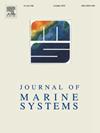Spatial and seasonal variability of Arctic phytoplankton communities in conditions of interaction with Atlantic origin waters in the St. Anna Trough (Kara Sea)
IF 2.5
3区 地球科学
Q2 GEOSCIENCES, MULTIDISCIPLINARY
引用次数: 0
Abstract
For the first time, seasonal changes in phytoplankton communities were described in the Kara Sea region, which is influenced by modified Atlantic water through the St. Anna Trough. The study focused on June, when the sea ice began to retreat, July after three weeks without sea ice, and September, when Siberian river discharge had a widespread surface impact. In all seasons, the structure of the phytoplankton community differed significantly on the outer shelf of the Kara Sea and the slope of the St. Anna Trough. This boundary was caused by changes in the hydrophysical structure and was located approximately at 76.5 N, with a width of about 20 km. The highest phytoplankton abundance, biomass and photosynthetic activity were observed on the outer Kara Sea shelf in the cold winter layer with temperature ranging from −1.7 to −0.5 °C and salinity ranging from 32.5 to 33.7. In June and July, the layer was located in conditions with sufficient underwater irradiance and nutrient supply. The integral abundance and biomass of algae differed 10–20 times between the outer shelf of the Kara Sea and the slope of the St. Anna Trough, where this layer was not present. In September, stratification on the Kara Sea shelf increased under the influence of pronounced river runoff, and the cold winter layer became thinner and deeper, with a significant decrease in phytoplankton abundance. Despite the high similarity (61–64 %) in species composition between the outer shelf and slope of St. Anna, there were differences in dominant species between the areas each month. In June the spring diatoms Chaetoceros socialis, Fragilariopsis spp. (F. cylindrus, F. oceanica) and Navicula pelagica mass developed on the Kara Sea outer shelf, while Phaeocystis pouchetii did on the slope of the St. Anna Trough. In July, resting spores of Chaetoceros socialis, as well as Apedinella radiance, and Choanoflagellates prevailed on the shelf, but Dicrateria sp. was the most abundant in the St. Anna Trough. In September Leptocylindrus danicus, Peridiniella catenata and Thalassionema nitzschioides were the base of community on the outer shelf, however Thalassiosira cf. levanderii, Leptocylindrus minimus, Nephroselmis sp. dominated on the slope. The “Atlantification” through the St. Anna Trough in June and July had a similar effect on the phytoplankton in the Kara Sea's outer shelf as it did on the phytoplankton communities in the Polar Front area of the Barents Sea during April–May.

圣安娜海槽(喀拉海)与大西洋原水相互作用条件下北极浮游植物群落的空间和季节变化
首次描述了喀拉海区域浮游植物群落的季节变化,该区域受经过圣安娜海槽的大西洋海水的影响。研究集中在海冰开始消退的6月,没有海冰的3周后的7月,以及西伯利亚河流量对地表产生广泛影响的9月。各季节喀拉海外陆架和圣安娜海槽坡浮游植物群落结构差异显著。该边界是由水体物理结构变化引起的,大约位于北纬76.5度,宽度约20 km。在温度为- 1.7 ~ - 0.5°C、盐度为32.5 ~ 33.7的寒冷冬季层,外喀拉海陆架浮游植物丰度、生物量和光合活性最高。6月和7月,该层处于水下辐照度和养分供应充足的条件下。喀拉海外陆架与圣安娜海槽坡间的藻类整体丰度和生物量差异达10 ~ 20倍。9月,受河流径流影响,喀拉海陆架分层增加,冬冷层变薄、变深,浮游植物丰度明显下降。尽管圣安娜陆架与坡区物种组成具有较高的相似性(61 ~ 64%),但各月间优势种存在差异。6月,喀拉海外陆架发育了春季硅藻群:社会毛藻群、脆弱藻群(圆柱藻群、海洋藻群)和远洋Navicula pelagica群,圣安娜海槽坡发育了袋囊藻群。7月,陆架上以社会毛角虫(Chaetoceros socialis)、辐尾虫(Apedinella radiance)和choano鞭毛虫(Choanoflagellates)的静止孢子为主,但圣安娜槽中以Dicrateria sp.最多。9月外陆架的群落基础为丹麦细螺旋体、长链细螺旋体和细链细螺旋体,坡面主要为leanderii细螺旋体、小细螺旋体和细螺旋体。6月和7月通过圣安娜海槽的“大西洋化”对喀拉海外大陆架浮游植物群落的影响与4 - 5月对巴伦支海极地锋区浮游植物群落的影响相似。
本文章由计算机程序翻译,如有差异,请以英文原文为准。
求助全文
约1分钟内获得全文
求助全文
来源期刊

Journal of Marine Systems
地学-地球科学综合
CiteScore
6.20
自引率
3.60%
发文量
81
审稿时长
6 months
期刊介绍:
The Journal of Marine Systems provides a medium for interdisciplinary exchange between physical, chemical and biological oceanographers and marine geologists. The journal welcomes original research papers and review articles. Preference will be given to interdisciplinary approaches to marine systems.
 求助内容:
求助内容: 应助结果提醒方式:
应助结果提醒方式:


